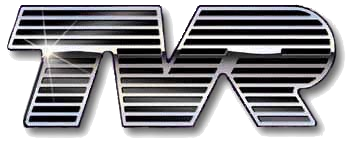


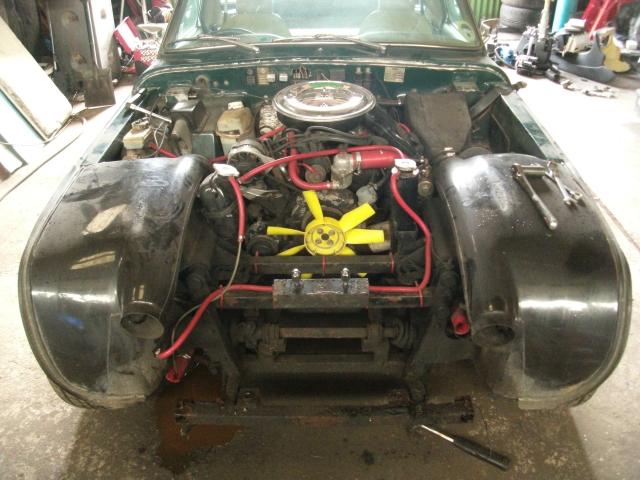
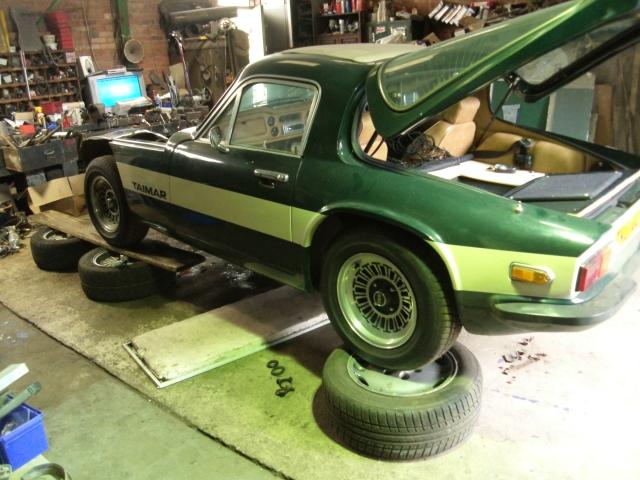

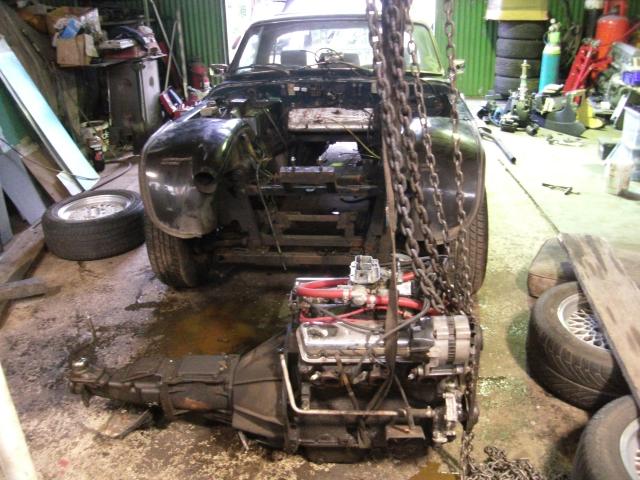
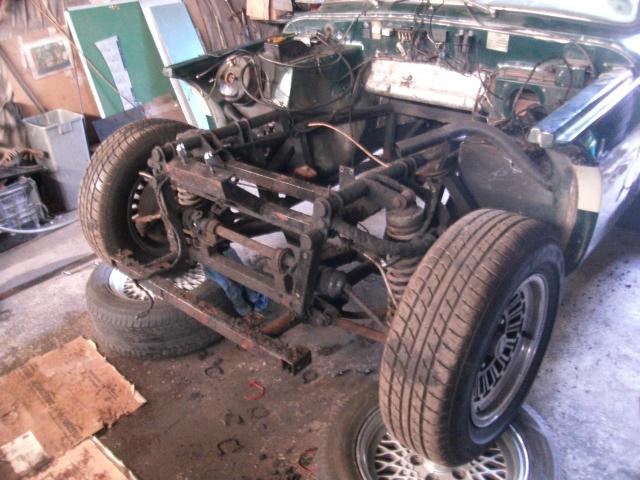
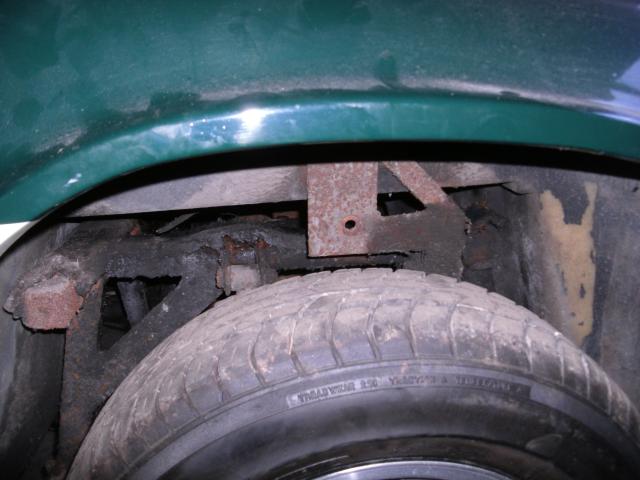
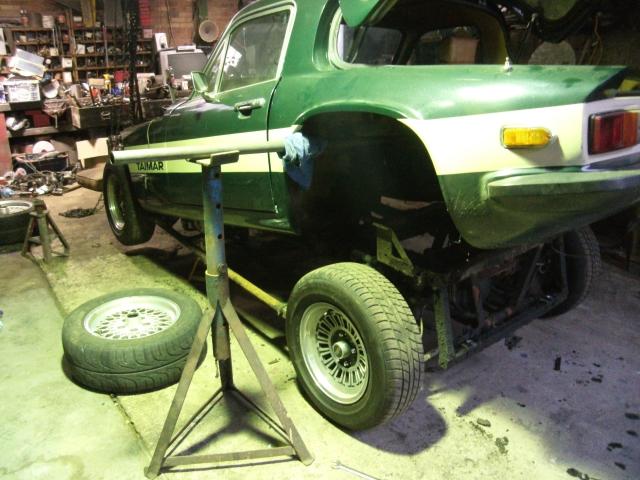
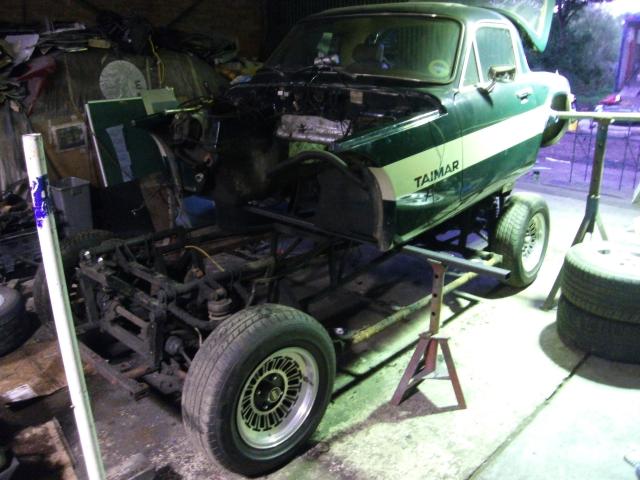
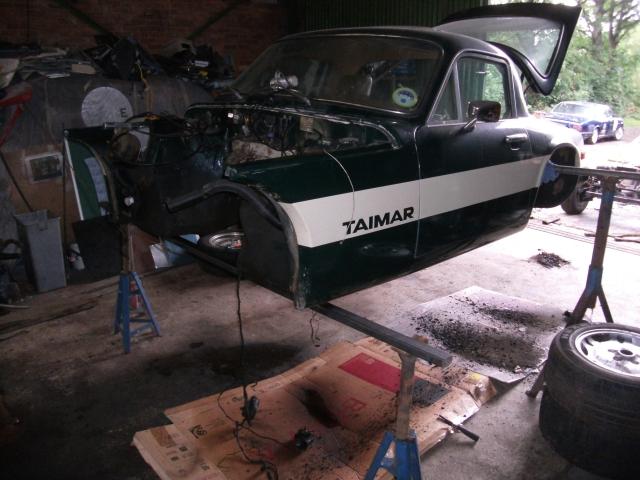
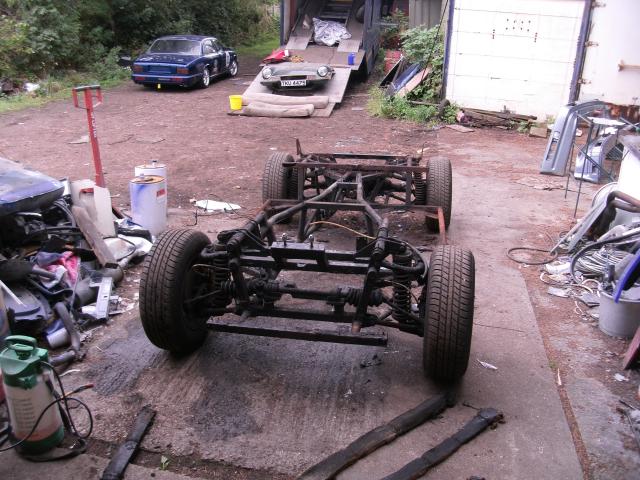
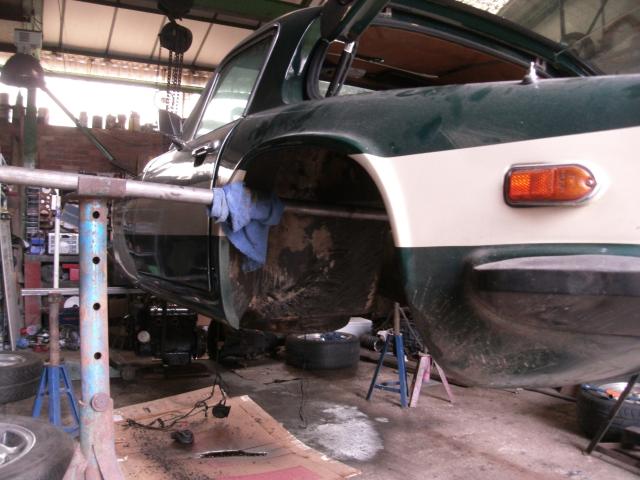
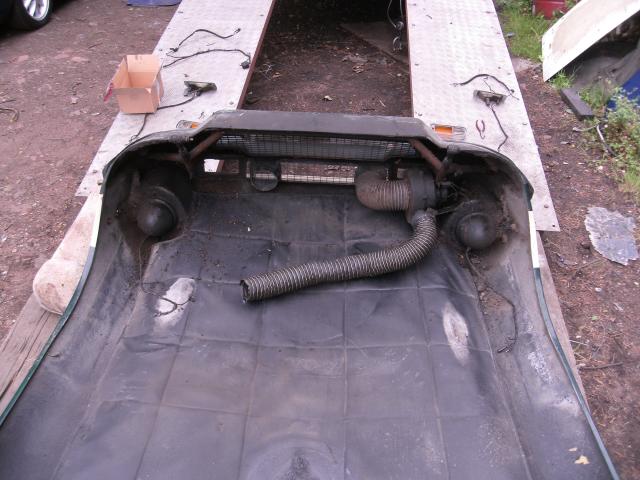
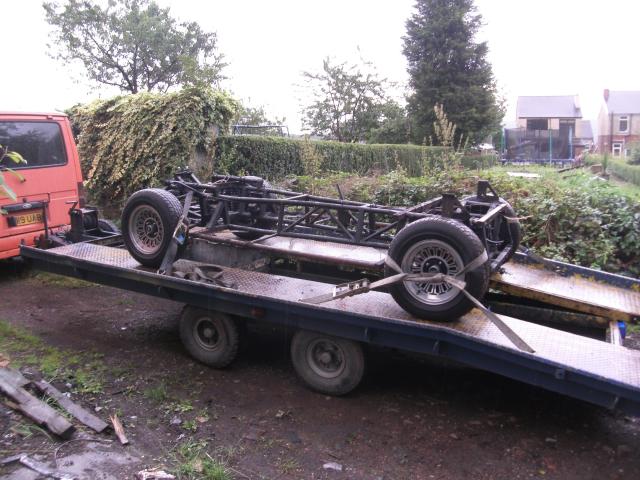

PART 1 - Disassembly.
The Taimar is a classic TVR construction. Simple boxy chassis with a fibreglass shell dropped on top. A green one in this case, with that ‘70s stripe on the flanks in a shade they called biscuit. Only 6 green ones ever made, even we have to factor this sort of thing into our calculations, it is not time to go modification mad. A “sensitive” restoration is not what you would normally associate us with, but we were into old cars before we started racing Jags, and this is a nice change of scenery.
Still going to get the Kutuka flat-out place, but in a different way. And the novelty of imperial spanners is a nice change too.
So, restoration will be limited to the mechanicals. The body, despite the ancient fibreglass and paint with the tiny bubbles in, will not be touched, it is as it was and perhaps should stay.
On the list is the gearbox, exhaust, and diff. We’ve never done a TVR before, but a bolt is a bolt, and removing just two of them allows you to walk off with a third of the car, the bonnet, complete with its inner frame, headlights and grille. In fact, a closer look reveals that all three are actually bonded into the bonnet, which is both crackers, and to be expected. With the best will in the world, nobody expects a car assembled like a canoe by a couple of blokes in a shed in 1970s
Fortunately, grease has protected the steelwork, so it is all intact.
Time for the engine out. Our lack of knowledge and foresight does present itself here. Not in the removal, that was fine, but the fact we did it at all. Removal is no different to our racing cars, unhook everything and yank it out of the car. Space is a bit tight, because it’s a big 3 litre
Construction of the car is weird in many ways. The spare wheel carried right at the front, above the radiator. The short, squat, deep radiator which might be to allow for the spare wheel. Separate header and expansion tanks on opposing sides of the vehicle. But there is something appealing about the oddness. It couldn’t be anything but an old TVR.
Radiator, upon removal, appears to require repair, nothing major, but a trip to the specialists for a quick bit of brazing will be necessary. The electric fan is the size of a wristwatch. The entire cooling system is removed, but it’s all bolts of one size, with a 7/16 socket you can remove half the car.
Throttle is connected to this strange device they call a carburettor, which is most peculiar. But without much ado, and with some relief that someone has been in here before, every hose, clip, cable and clamp comes off.
Bear slithers beneath to remove the world’s shortest propshaft, two rather rusted exhausts, and the headache of the strange gearbox crossmember. Off with the engine mounts, and the struggle then to slide the whole assembly out. The angles required, and the sequence needed, suggested that really they planned for you not to bother doing this. But, out it comes, successfully, without so much as a scratch.
Now comes the stupid part. We’ve got to this point in a single evening. With 2 full weeks to play with, Bear gets ambitious. He decides to take the body off the chassis. There is one rather obvious question to ask. Why take the engine out of the car, if you’re going to take the body off the chassis. Erm. Well. Er. Practise?
Hell with it, let’s take this thing to bits. Brake system all comes off, servo and the lot. Heater airbox, and the fibreglass inner wings to boot.
Then the Bear goes quiet for a bit, and there is the noise of spannering from beneath. With the aid of his humble assistant, 10 bolts come out. Four in each floorpan, two in the footwell, two behind the seat, per side. Two in the rear of the chassis. The online article he read says it now comes apart.
It is a lie. This is a Taimar, the guide is for an older model, there are 4 more. Why? Because TVR are working with a fibreglass car they do need some steel to anchor things to, like the seatbelts.
You can’t just bolt the seatbelt to the body, there’s nothing there, they have to specifically add something to attach it to. A good number of bolts here therefore do two jobs, they anchor body to chassis, and seatbelts to chassis. The inertial reel belts in this car are on the rear wheelarches with two bolts per side, and they bolt through the tub to the chassis, so have to come off too. 14 bolts for a Taimar. 14.
A tentative lift reveals that the entire body is now loose. What we now need is muscle power. Again, the handy article says use 5 men for this job, four to lift, one to move axle stands about the place and check for things catching. We don’t have 5 men. We have two, one of who has bad knees.
What we do have, however, are big axle stands. Huge. In keeping with the car’s previous owner, we use lorry stuff for this. Each stand is waist-high before you even start.
A length of CDS rollcage tube comes out of stock, and it goes nicely all the way through from one side of the car to the other without hitting anything chassis-related. The shell is strong enough at the rear to jack up without any sickening crunching sounds, and that gets us high enough to get the ends of this tube onto both stands.
It is then a simple task. One brother without ruined knees lifts one end of the tube, whilst the other raises the stand, then we skip gaily round the car to the other side, and repeat. We will concede it is a bit of a weight to shift in such a manner, but up she goes. We only lift the rear. You have to lift the rear first, because the handbrake stays attached to the chassis, and to get it out from inside the body it must come out at this angle.
By degrees, she goes high enough to clear. Now for the front. The awkward part here is that the handbrake is on, and we need to roll the chassis forward as the body comes upwards, but it is only a minor complication, and the weight in the front of the body is far, far less. All told, less than an hour to lift the body off the chassis, and only one head wound. This leaves us with a body up in the air perched on 4 large axle stands and an unborn rollcage, with a chassis that rolls out from beneath into the chirping dusk of a Yorkshire summer evening. We are 2 evenings into the project.
There is no question about it, for us this is a strange notion. To have the painted car, complete with interior and wiring, sitting up in the air in the garage, but with the chassis and drivetrain out here, well it’s just plain weird. A small electrical screwdriver sits atop one of the crossbraces, clearly stashed there by our late uncle when under the car and forgotten. Father identifies it as one of his own. The memory of his late brother forever stealing his tools is as close to a gentle and poignant moment as we ever get.
How far are we going with this? We don’t get know. Bear loads up the chassis, carts it off and steam-cleans it. All those years of grease take some blasting off, but he does locate the bare bones of this car.
TVR operated in a way that we can fully empathise with. There are 35 year-old tie wraps, still resolutely doing their job of holding the fuel and brake lines to the chassis. You have to like that. The Jags we know and love have metal clips, and rivets, sometimes with inserts, and bolts, and rubber lined clamps. TVR used a tie wrap. That all are intact, every last one, suggests they were right not to over-think it.
And that also means that in a flurry of snipping, all these bits come off. There is a cursory attempt at sound-insulating the chassis from the body. Felt adorns the top of the chassis at the rear, and rubber pads isolate the floorpans. We’re not certain that they are in any way shimmed, but we store them so that they will go back where they came from.
The handbrake leaps off in moments, and in the space of one day after removal the suspension all leaps off. Shocks are all coil-over. The diff is mounted to the chassis itself, no subframe. Rubber mounted, but that’s not a terrible idea, isolates it to some extent from the shock of hard acceleration, no broken bolts here. The top frame that holds them in is massively robust, and rather crude. In fact, a critical look suggests that the twin rails to this thing aren’t in fact parallel, this is the work of some bloke probably called Steve measuring by eye, it’s not any better than we could turn out here. And that’s the charm to this car in many ways.
The twin wishbones bolt direct to the chassis, simple telescopic driveshafts, but it all comes to bits. The bushes were all hidden beneath grease, so nothing was seized in place save for the pins in the rear uprights. With a ¾ spanner and a socket you can take the entire suspension off the car.
And that leaves us with what is basically a ladder. I’ve never seen a car so naked. And light. Bear can pick it up and walk off with it. Helpful.
The chassis is not sophisticated. If they wanted a kinked cradle for the engine, it wasn’t pressed, formed or bent. They chopped it off, welded a new bit at an angle, and then continued. But clearly it worked. The wishbones have adjustment built in for camber, and even rear toe, but as an afterthought. They didn’t redesign a new wishbone, they chopped the old mount off and brazed an adjustable ladder bolt in there. You can see it plainly, the original line of the wishbone doesn’t actually hit the mounting point, these must belong something else and get a local adaptation to make it TVR. But that’s fine, we understand such engineering.
A few minor components like brake servo come off the body, mostly for a little paintwork, but also so that we can establish that it will actually come off should we ever need to. The cotter pin says that this car is 35 years old, but it eventually accepts defeat. It is in fact the most reticent piece on the entire car thus far, about the only thing that didn’t get greased within the first week of its life.
After three days at it therefore, this car is fully stripped. The chassis is a bare frame without a single nut, bolt or clip on it. All the bolts are carted away for plating. The engine is sitting in the degreasing tray, the body is floating up in the air, this car is not going anywhere. At the end of this orgy of destruction, there is a moment at which you look about, take stock, and ask what you’ve done.
Time to start the renovation.
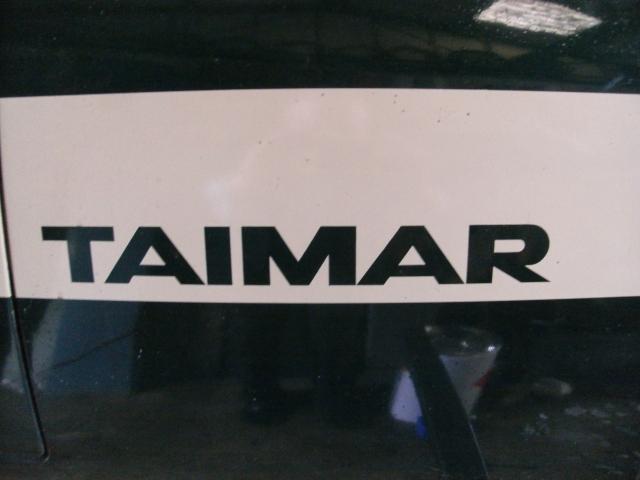
And so it begins...
2 bolts, and you can walk off with the bonnet.
Radiator has gone walkabout. Signs of Bear's previous attack on this car are clear. Silicone hoses, and the chromed affection of an air filter housing.
This garage has seen a few engines out in the past few years. This 3 litre Essex is the smallest one since 1989.
Crude but effective. One day we will buy a proper lift, but until then, this works as well as anything.
Snoozing Bear, hidden Trevor.
Getting friendly with the underpinnings in his search for the bolts that link chassis to body.
An amazingly small number of bolts held the inner wings on. And now we have a large go-kart.
Any E-type owners at this point are asking "well, so what?"
And the body starts to lift clear of the chassis.
The angular structure is the rearmost seatbelt anchorage.
Huge axle stands and a length of rollcage tube. It might not be the factory method (or it might have been, actually!) but it works.
Body off.
For those who have only ever worked on monocoque cars, this is a really odd moment.
Something missing here.
This is the part that we're not really going to touch. To restore this part would be somehow a bit too much.
That's not to say that the Bear won't clean 35 years of crud off the underside of it.
At least it can't go rotten!
Shed of the engine and box, we now have a large supermarket trolley. With slightly better steering.
The bonnet refuses to let go of many of the parts it has attached. And as there's nothing wrong with them, why disturb it?
We see full race cars tied on less securely than this.
Off for steam cleaning.
Steam cleaned, and you have to say it looks like this was a "just in time" renovation.
Suspension off next, then time for some TLC.